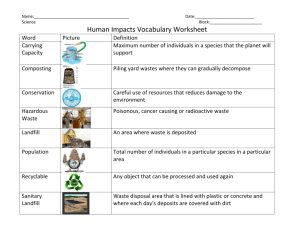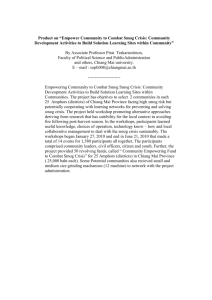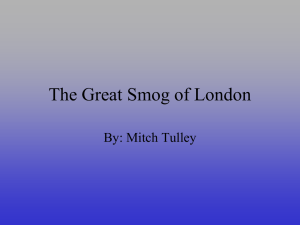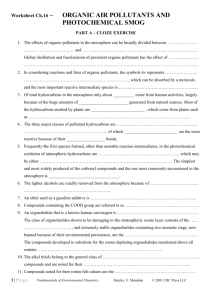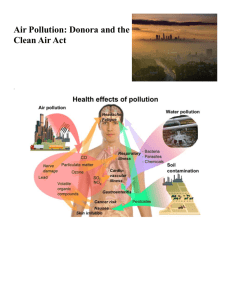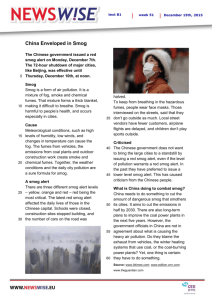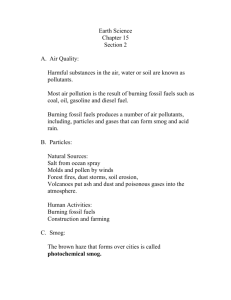Part1. Classical and photochemical smog. 1. What is smog?
advertisement
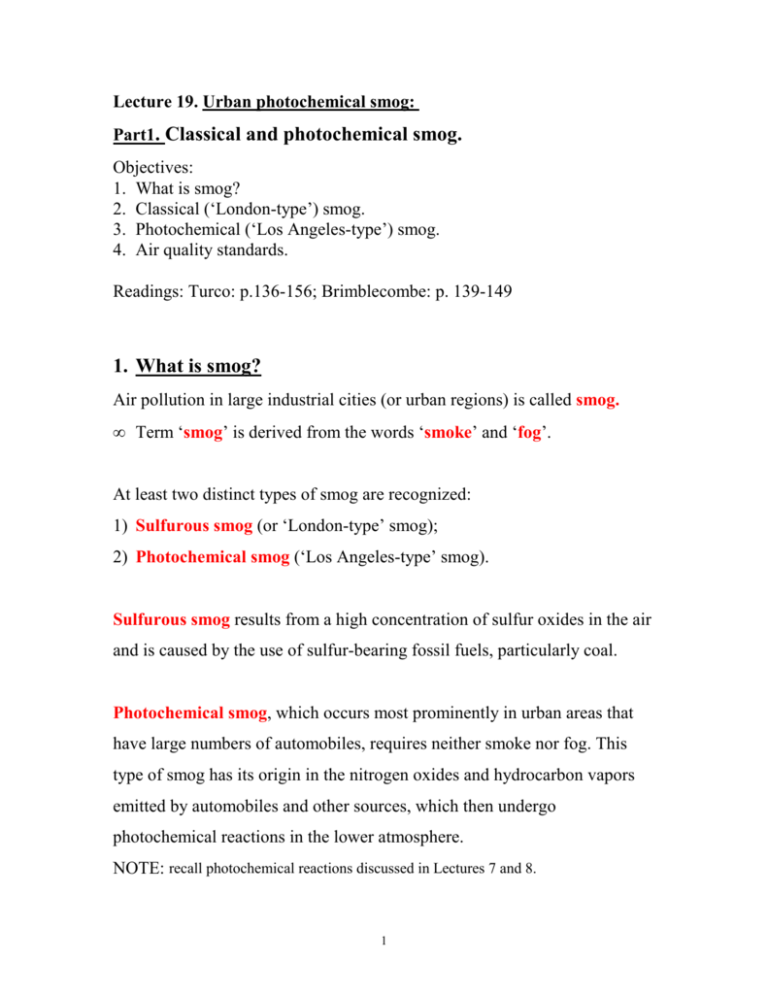
Lecture 19. Urban photochemical smog: Part1. Classical and photochemical smog. Objectives: 1. What is smog? 2. Classical (‘London-type’) smog. 3. Photochemical (‘Los Angeles-type’) smog. 4. Air quality standards. Readings: Turco: p.136-156; Brimblecombe: p. 139-149 1. What is smog? Air pollution in large industrial cities (or urban regions) is called smog. • Term ‘smog’ is derived from the words ‘smoke’ and ‘fog’. At least two distinct types of smog are recognized: 1) Sulfurous smog (or ‘London-type’ smog); 2) Photochemical smog (‘Los Angeles-type’ smog). Sulfurous smog results from a high concentration of sulfur oxides in the air and is caused by the use of sulfur-bearing fossil fuels, particularly coal. Photochemical smog, which occurs most prominently in urban areas that have large numbers of automobiles, requires neither smoke nor fog. This type of smog has its origin in the nitrogen oxides and hydrocarbon vapors emitted by automobiles and other sources, which then undergo photochemical reactions in the lower atmosphere. NOTE: recall photochemical reactions discussed in Lectures 7 and 8. 1 2. Classical (‘London-type’) smog. London-type smog occurs in the regions where 1) emission of the sulfur-containing compounds is high (due to burning of coal to generate heat and energy); 2) air contains high liquid water contents (e.g., fogs). Fog is the dispersed water drops. Fogs can be viewed as clouds that are in contact with the Earth’s surface. Fogs are created during cooling of air next to the Earth’s surface either by radiation to space (radiation fogs) or by a contact with a surface (advection fogs). Burning of coal produces sulfur dioxide, soot and other gases and particulates, which are called smoke. • The typical London smog results from the accumulation of smoke from coal burning, which has a high sulfur content. It leads to the production of high concentrations of sulfuric acid in fog droplets. These acidic particles, along with high densities of smoke, inhibit the normal functioning of the lungs and can cause death. In the atmosphere, sulfuric acid particles can be formed in two ways: 1) Direct dissolution of SO2 into water drop and subsequent aqueous-phase oxidation to sulfate (will be discussed in Lectures 22-23 on acid rain formation); 2) Gas-phase conversion of SO2 to sulfuric acid gas (H2SO4), which has a low surface vapor pressure, and therefore, easily condenses onto particles. The gas phase conversion requires three steps: SO2 + OH + M HSO3 + M HSO3 + O2 SO3 + HO2 SO3 + H2O H2SO4 2 3. Photochemical (‘Los Angeles-type’) smog. Los-Angeles-type smog occurs in the regions where 1) high emissions of automobiles; 2) large concentrations of reactive hydrocarbons (RH) (from automobile exhaust or from other natural or anthropogenic sources); 3) plenty of sunlight (high level of UV radiation) Photochemical smog forms primarily as a result of interactions among nitrogen oxides (NOx = NO + NO2), reactive hydrocarbons, and sunlight. How it works: Primary pollutants NO and reactive organic vapors, RH, are emitted from automobiles. . First, RHs are chemically transformed to radicals, denoted R RH + OH R. + H2O R. + O2 + M RO2. + M NOTE: The organic radical, R., can be composed of many atoms and have a complex molecular structure. Then organic radicals react with nitric oxide, NO, to form nitrogen dioxide, NO2: RO2. + NO RO. + NO2 However, in urban air, the sun breaks NO2 back to NO and O NO2 + hν NO + O , at wavelength < 0.42 µm Atomic oxygen produces ozone, O3, which is of primary concern in photochemical smog: O + O2 + M O3 + M Thus, the overall process of smog formation can be summarized as RH + HO + NO + hν … O3 + NO2 + HC 3 ⇒ Most of the world’s energy comes from the burning of organic compounds, whether they represent the organic matter of wood or the hydrocarbons of natural gas, coal, petrolium (oil), and other fossil fuels. Do you know that: ∗ combustion of fossil fuels account for about 85% of all energy consumed in the United Sates in 1995 and is expected to remain close to this level through 2015; ∗ each year the United States consume about 6 billion barrels of oil, more than the total used by Japan, Germany, Italy, France, Canada, and Great Britain combined. ∗ in the United States alone, close to 200 million motor vehicles of all kinds burn more than 140 billions gallons of gasoline and diesel fuel each year as they travel about 1012 miles. Gasoline is a mixture of over a hundred different alkanes, alkenes, and aromatic hydrocarbons to make an effective fuel for the internal combustion engine. NOTE: recall Lecture 8 on classification of organic compounds. Basic classification of hydrocarbons: • Alkanes (or paraffins) are hydrocarbons with a single carbon-carbon bond. The general formula for the alkanes is CnH2n+2. Mixture of alkanes are found both in petrolium and natural gas. Natural gas is 60 to 95% methane (CH4) and contains smaller amount of ethane (C2H6), propane (C3H8), butane (C4H10), and pentane (C5H12). Petrolium is a more complex mixture of alkanes. • Alkenes (or olefins) are hydrocarbons with a double carbon-carbon bond. The general formula for the alkenes is CnH2n. Alkynes are hydrocarbons with a triple carbon-carbon bond. The general formula for the alkynes is CnH2n-2. • Aromatic hydrocarbons are hydrocarbons which contain at least one ring of six carbons (benzene). 4 ♦ The most widely emitted organic species in the Los Angeles basin are methane, toluene, pentane, butane, and ethane. Let’s apply ‘How it works’ scheme for a case of ethane: Ethane is emitted from automobiles. First, a hydroxyl radical attacks ethane, CH3CH3, by abstracting a hydrogen atom to . form ethyl radical, CH3CH2 : CH3CH3 + OH CH3CH2. + H2O . Ethyl radical, CH3CH2 , reacts quickly with oxygen in the presence of a third body to form an ethylperoxy radical via CH3CH2. + O2 + M CH3CH2 O2. + M The ethylperoxy radical then reacts with nitric oxide to form nitrogen dioxide and ethoxy radical, : CH3CH2 O2. + NO NO2 + CH3CH2 O. Then NO2 goes to form O3, and ethoxy radical goes into a chain of reactions. Hundreds of different compounds may be produced by the reactions of RH. One of the most important is peroxyacetylnitrate (PAN). Thus, secondary hydrocarbons are important components of photochemical smog. ♦ Along with NOx and organic gases, carbon monoxide is a key component of smoggy air. However, its atmospheric chemistry is very simple: CO + OH CO2 + H 5 Photochemical smog formation: Initial stage: NO, CO, RH Final stage: O3, NO2, PAN (and other hydrocarbons), haze (aerosols) NOTE: photochemical smog evolves in time (will be discussed in Lecture 20). NOTE: effects of atmospheric aerosols on regional scale is discussed in Lectures 25-26. • Many big cities exhibit photochemical smog, including Mexico City, Tokyo, Johannesburg, and Athens, among others. Table 19.1 Percent of CO, NOx, SOx = SO2 + SO3, and reactive organic gases (ROG) emissions by source category. CO NOx SOx ROG Fuel combustion 1.56 22.1 17.28 1.22 Waste burning 0.06 0.14 0.34 0.08 Solvent use 0.00 0.02 0.00 33.72 Petroleum process/ 0.13 0.75 14.40 7.75 Industrial processes 0.14 0.96 5.66 2.99 Construction, etc. 0.11 0.06 0.06 4.19 Total stationary sources 2.00 24.03 37.74 49.95 On road vehicles 87.47 54.97 23.53 43.96 Other mobile 10.53 21.0 38.73 6.09 Total mobile sources 98.0 75.97 67.26 50.05 Stationary sources storage/transfer Mobile sources 6 Table 19.2 Comparison of general characteristics of sulfurous ‘London-type’ smog and photochemical ‘Los Angeles-type’ smog. Characteristics Sulfurous (London-type) Photochemical (Los Angeles-type) First recognize Centuries ego Mid-1940s Primary pollutants SO2, soot particles NOx, organics Secondary pollutants H2SO4, sulfate aerosol, etc. O3, PAN, organics, acids, aerosols, etc. Temperature Cool (< 35oF) Hot (> 75oF) Relative humidity High, usually foggy Low, usually hot and dry Type of temperature Radiation inversion Subsidence inversion Early morning Noon-evening inversion Time air pollution peaks 4. Air quality standards. ♦ Because air pollution is recognized as a hazard to the health, a set of standards has been established to indicate the amounts of pollutants in air and provide guidelines for the likely effects of that pollution on health. Clean air means air in which pollution concentrations fall below the standards. Above the standard, air pollution is likely to cause long-term health effects in many people. • California has its own air quality standards, which are tougher than federal. 7 Table 19.3 Standards for air pollution. Pollutant CO O3 NO2 SO2 PM10 Sulfates Lead Hydrogen sulfide Vinyl chloride California/ California/ California/ California/ Time of Federal Federal Federal Federal exposure standard Stage 1 Stage 2 Stage 3 9.3 ppm 9.5 ppm 0.09 ppm 0.12 ppm 0.25 ppm 0.053 ppm (annual avg.) 0.05 ppm 0.14 ppm 50 µm/m3 150 µm/m3 25 µm/m3 50 µm/m3 150 µm/m3 0.03 ppm 0.03 ppm - 20 ppm 15 ppm 0.2 ppm 0.2 ppm 0.6 ppm - 35 ppm 30 ppm 0.35 ppm 0.35 ppm 1.2 ppm - 50 ppm 40 ppm 0.5 ppm 0.5 ppm 1.6 ppm - 12-hr avg. 8-hr avg. 1-hr avg. 1-hr avg. 1-hr avg. 24-hr avg. 24-hr avg. 24-hr avg. 24-hr avg. 24-hr avg. 30-hr avg. 90-hr avg. 1-hr avg. 24-hr avg. PSI, pollutant standard index, is a relative scale of air quality that applies to all pollutants. The index is calculated by projecting the measured average concentration of a pollutant onto a scale that ranges in value from 0 to 500. On the PSI scale, the federal standard concentration would have a PSI of exactly 100. ‘Good air’ is air with PSI value of 0 to 50. 8 Figure 19. 1 The quality of air based on the pollutant standard index (PSI). 9
